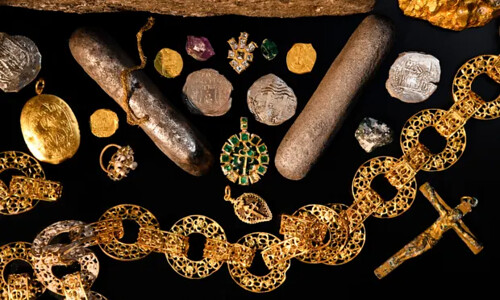
PREV ARTICLE
NEXT ARTICLE
FULL ISSUE
PREV FULL ISSUE
V25 2022 INDEX E-SYLUM ARCHIVE SPANISH GALLEON MARAVILLAS FOUNDCoins aren't mentioned in this Guardian article, but the image of artifacts recovered from the wreck of the Nuestra Señora de las Maravillas shows gold, jewellery and coins. -Editor It was a Spanish galleon laden with treasures so sumptuous that its sinking in the Bahamas in 1656 sparked repeated salvage attempts over the next 350 years. So when another expedition was launched recently, few thought that there could be anything left – but exquisite, jewel-encrusted pendants and gold chains are among spectacular finds that have now been recovered, having lain untouched on the seabed for hundreds of years. The Nuestra Señora de las Maravillas (Our Lady of Wonders) went down on the western side of the Little Bahama Bank, over 70km offshore, but the newly discovered treasures were found across a vast debris trail spanning more than 13km. Allen Exploration, with Bahamian and US marine archaeologists and divers, was licensed by the Bahamian government to explore the Maravillas scientifically and is committed to displaying the finds in a new museum in the Bahamas. An elaborate, gold filigree chain, with rosette motifs, is among treasures that suggest some of the discoveries were destined for wealthy aristocrats, if not royalty. A gold pendant bearing the Cross of Santiago (St James) and an Indian bezoar stone, then valued in Europe for its healing properties, is shaped like a scallop shell, the symbol recognised by pilgrims heading for Santiago de Compostela in Galicia. It is among finds linked to the sacred Order of Santiago, a military-religious order of knights, who protected pilgrims and were active in Spain's maritime trade. Another pendant features a gold Cross of St. JamesSantiago over a large, green, oval emerald framed by a dozen square emeralds, perhaps symbolising the 12 apostles. Clusters of emeralds and amethysts mined in Colombia and now recovered offer evidence of contraband trafficking as they were not registered on the manifest.
Dr Sean Kingsley, an English marine archaeologist and editor of
Wreckwatch magazine which will feature the finds in a forthcoming issue, told the Observer that such The expedition is also collecting data on the reef health, seafloor geology and plastic pollution to understand how the archaeology and marine environment interact.
To read the complete article, see:
Wayne Homren, Editor The Numismatic Bibliomania Society is a non-profit organization promoting numismatic literature. See our web site at coinbooks.org. To submit items for publication in The E-Sylum, write to the Editor at this address: whomren@gmail.com To subscribe go to: https://my.binhost.com/lists/listinfo/esylum All Rights Reserved. NBS Home Page Contact the NBS webmaster 
|

